Teaching History through Wargaming: Strategy & Tactics #280: Soldiers 1918
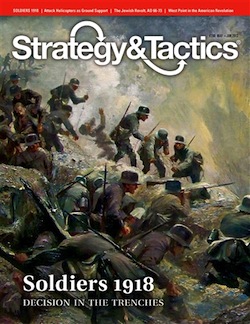 I’ve been a history buff all my life, and this interest led me to a career as an archaeologist before becoming a writer specializing in history and historical fiction. Thus it’s not surprising that I want my ten-year-old son to have a firm grounding of history, even though he takes more after his astronomer mother and will almost certainly go into one of the STEM fields.
I’ve been a history buff all my life, and this interest led me to a career as an archaeologist before becoming a writer specializing in history and historical fiction. Thus it’s not surprising that I want my ten-year-old son to have a firm grounding of history, even though he takes more after his astronomer mother and will almost certainly go into one of the STEM fields.
One of my main interests is World War One, so when I visited Belgium a couple of years ago for the centenary I brought him back some Belgian comics on the conflict. Now we’re watching the excellent Channel Four series The First World War. I’m also vocally hoping he’ll read my Trench Raiders series, so far with no luck! I’ve been pushing this particular era of history because we live in Madrid. Since Spain wisely stayed out of the war, I don’t think the Spanish educational system will teach him as much about WWI as I think he should know.
So why not add a little extra knowledge through wargaming? He’s been expressing an interest in it lately since his favorite comics shop has some wargaming tables, so I invested in issue #280 of Strategy & Tactics, a classic wargaming magazine that’s older than I am. This issue comes with the game Soldiers 1918: Decision in the Trenches, which one BoardGameGeek labeled as “medium light” in difficulty.
The game is pretty straightforward. One side takes the role of the Germans, defending a system of trenches and bunkers as the other player, playing the Americans, attacks. Both sides are supported by artillery, which the Americans have to plan out in advance for the entire six turns of the game, while the Germans, since they have communication lines within their trenches, only have to do one turn ahead of time. Combat results are determined by summing up the attack strength over the defense strength (determined by terrain), and thus making a ratio that determines the roll you need on a six-sided to to destroy the target. This gave my son more practice with fractions than he gets in a week of math class!
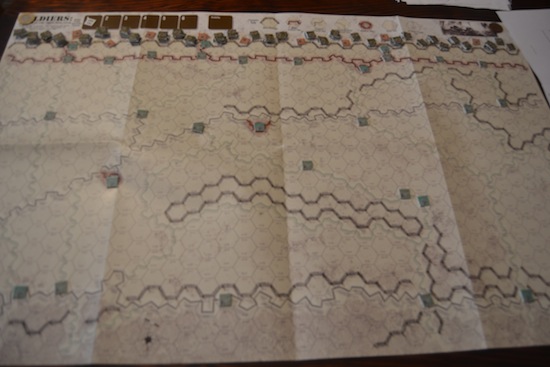
The view from the German lines as the Yankees mass in front of their wire.
Blurriness is due to the fog of war and poison gas, not bad photography
Movement is hampered by barbed wire, trenches, and dead bodies. There’s also a nasty random number of COWed units, that don’t get to fight for the entire turn, because in real life all sorts of things went wrong with individual units that slowed their progress and stopped them from obeying orders.
The rules were straightforward enough that my kid grasped them easily enough, and the game came with handy sheets for the most important information and counters to keep track of turns and phases. He liked that the terrain was based on an actual German trench system from the Arras sector.
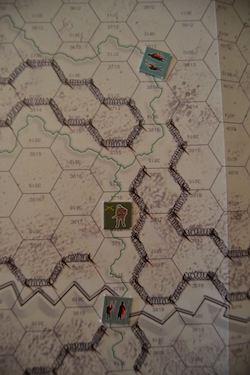
The game is played by having one player defend and the other attack. Then the players switch roles. Whoever penetrates the line furthest wins. The game designer warns that breaking through the other other end of the board, and thus instantly winning the game, almost never happens. Thus the “winner” is actually the person who loses less. That pretty much sums up World War One!
I played the Germans first, and my son got a good sense of the insanity of assaults against barbed wire and trenches when he lost a third of his men before he fully got through the wire. Once he was in the trench system things got tougher for me. My artillery almost never managed to kill his units, even if they were in the more lightly protected communications trenches. This, too, is historically accurate. My losses began to mount but the machine guns in my bunkers withered away his force as he wasted time killing off frontline units instead of pushing towards the rear. He actually replicated the flawed tactics of the early war! Even so, by the end of turn six he was fairly far advanced.
The next day we switched sides, and my American Doughboys charged bravely towards the sound of guns and fart noises. This time it only took a little over two hours because I whupped his ass because we were more familiar with the rules. I lost nearly all of my marines on the left as he focused fire on them (they have a better attack strength so he wanted to eradicate them), but my bombardment focused on and took out a key bunker early in the game, allowing me to move the regular U.S. Army troops in my center and right forward quickly. Imitating tactics from late in the war, I bypassed the defenders when possible in order to get as far into the enemy lies as possible. I made it to the end of the board by turn five, scoring an automatic win. I think the game designer was right, though. I doubt I would have made it that far if I was playing an adult opponent.
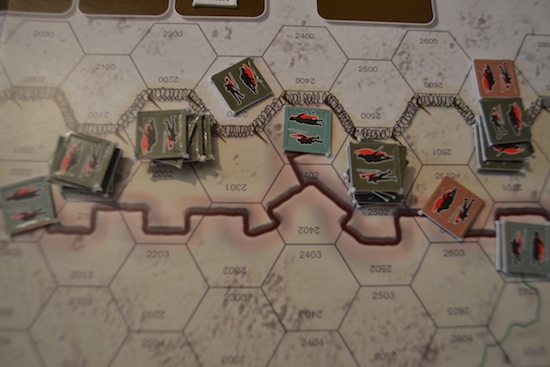
Yes, but at what cost?
Playing this wargame taught him some of the realities of trench warfare he won’t get from a documentary or comic — don’t bunch up your men, trenches are the original “safe space,” artillery is so hard to control that even your father can bomb his own guys, and if you don’t have a ten-to-one superiority when attacking a trench system you might as well forget it.
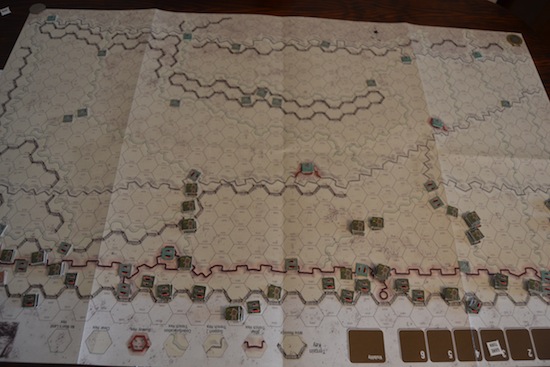
General Sean moving his men forward in the center and right, having lost most of his Marines on the left
All in all, a successful experiment! This game kept his concentration for three-and-half hours the first day, and two-and-a-half the second, a feat rivaled only by Minecraft, Lego, skateboarding, and football. And now he wants to try another game.
So, Black Gate readers, what other wargames would you suggest? It should be something at beginner or intermediate level, with smooth play and an attractive design. It also should be something affordable. I keep picking up games at the shop and going, “Oh, he’d like this. What? Eighty euros!!!” I’m a freelance writer, have mercy on me!
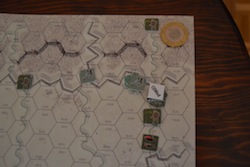
“Look, It’s the fabled giant 10-dirham coin of Berlin! We’ve won the war!!!”
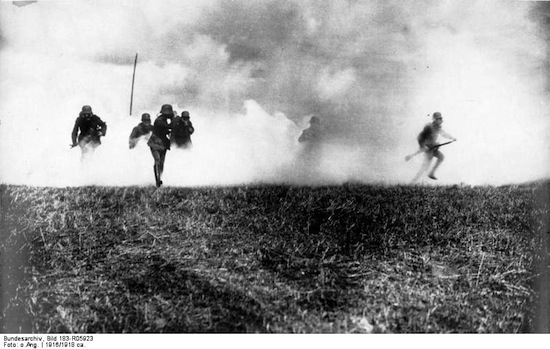
“Be grateful you don’t have to do this for real, kid!”
Sean McLachlan is the author of the historical fantasy novel A Fine Likeness, set in Civil War Missouri, and several other titles, including his post-apocalyptic series Toxic World that starts with the novel Radio Hope. His historical fantasy novella The Quintessence of Absence, was published by Black Gate. Find out more about him on his blog and Amazon author’s page.
I don’t know if they’re still in print, but The Gamers (now called Multi man Publishing, I think) put out some good ones. Afrika is a fast moving simulation of Rommel’s campaigns, and the Battle of the Bulge (a perennial wargamer’s favorite subject) was done by them in Ardennes.
You are certainly on the right track with games published in Strategy & Tactics. Back when SPI was the publisher, they put out a number of “quadrigames” (four games, magazine-sized, on the same historical conflict/period). Decision Games is re-issuing many of the old SPI titles, and they still hold up 30+ years after initial publication, with a good balance of simplicity, simulation, and playability. Given your work on A Fine Likeness, the Blue & Gray and <Blue & Gray 2 quads for the American Civil War would be natural choices.
There’s a magazine called Against the Odds that also publishes a game with each issue. They’re very well done.
I’d recommend Wooden Ships & Iron Men, by Avalon Hill, about famous battles between sailing ships. All the scenarios are historical, but one could go with hypothetical like say, Blackbeards Queen Anne’s Revenge vs. The Constitution.